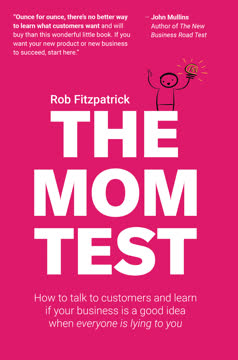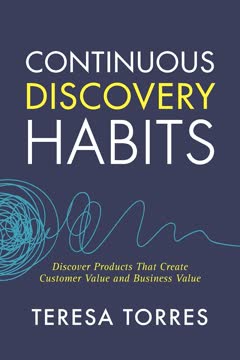つの重要なポイント
1. データ駆動型の意思決定はスタートアップの成功に不可欠
測定できないものは管理できない。
成功のための測定。 スタートアップの世界では、直感や仮定が誤解を招くことがあります。データ駆動型の意思決定は、起業家がアイデアを検証し、問題を特定し、迅速かつ効率的に解決策を最適化するのに役立ちます。関連する指標を収集し分析することで、スタートアップは以下のことが可能になります:
- ビジネスの最も重要な側面を特定し、集中する
- 推測ではなく証拠に基づいた意思決定を行う
- 課題に直面したときにより効果的に適応し、方向転換する
虚栄の指標を避ける。 すべてのデータが同等に価値があるわけではありません。スタートアップは、実際のビジネス価値を生み出す行動可能な指標に焦点を当てる必要があります。虚栄の指標の例には以下が含まれます:
- アクティブユーザーを考慮しない総登録ユーザー数
- コンバージョン率を考慮しないページビュー数
- バーンレートやランウェイを考慮しない総調達資金
2. 最も重要な指標(OMTM)は努力を集中させ、成長を促進する
ある時点で、最も重要な指標は一つだけです。
レーザーフォーカス。 OMTMの概念は、スタートアップが現在のステージとビジネスモデルにとって最も重要な単一の指標を特定し、集中することを奨励します。このアプローチは:
- チーム全体を共通の目標に合わせる
- 意思決定プロセスを簡素化する
- 迅速な反復と改善を可能にする
賢く選ぶ。 OMTMは以下の特性を持つべきです:
- 行動可能:あなたの行動によって直接影響を受ける
- 比較可能:時間や競合他社と比較して測定可能
- 理解しやすい:組織内の全員が理解しやすい
- 変化可能:ビジネスの成長や優先順位の変化に応じて進化する
異なるステージのOMTMの例:
- アイデア検証:問題インタビュー完了率
- MVPテスト:ユーザーエンゲージメント率
- 成長:バイラル係数
- 収益:顧客生涯価値(CLV)対顧客獲得コスト(CAC)比率
3. リーンアナリティクスのステージはアイデアからスケールまでのスタートアップを導く
リーンスタートアップは、適切なタイミングで適切なことに焦点を当てることに関するものです。
成長の5つのステージ。 リーンアナリティクスのフレームワークは、スタートアップが通常進行する5つの異なるステージを示しています:
- 共感:顧客の問題とニーズを理解する
- スティッキネス:ユーザーを引きつける製品を作る
- バイラリティ:口コミや紹介を通じてユーザーの成長を促進する
- 収益:製品やサービスを収益化する
- スケール:ビジネスを新しい市場やセグメントに拡大する
ステージ固有の焦点。 各ステージには独自の優先事項、課題、追跡すべき主要な指標があります。自分がどのステージにいるかを理解することで、スタートアップは:
- 適切な目標と期待を設定する
- リソースをより効果的に配分する
- 早すぎるスケーリングや誤った努力を避ける
スタートアップは、持続可能な成長のための堅固な基盤を確立するために、次のステージに進む前に各ステージをマスターすることに集中すべきです。
4. 異なるビジネスモデルには異なる主要指標が必要
自分がどのビジネスにいるのかを理解し、そのビジネスにとって重要な指標を見つける必要があります。
カスタマイズされたアナリティクス。 異なるビジネスモデルには独自の特性と成功要因があります。本書では、6つの一般的なビジネスモデルとそれに関連する主要指標を紹介しています:
- Eコマース:コンバージョン率、平均注文額、顧客獲得コスト
- SaaS:月次経常収益、チャーン率、顧客生涯価値
- モバイルアプリ:ダウンロード率、日次アクティブユーザー、ユーザーあたりの平均収益
- メディアサイト:ページビュー、サイト滞在時間、広告クリック率
- ユーザー生成コンテンツ:コンテンツ作成率、エンゲージメントファネル、バイラリティ
- 二面市場:流動性、マッチング率、取引量
モデル固有の最適化。 自分のビジネスモデルに最も関連する指標に焦点を当てることで、スタートアップは:
- 改善のための領域をより正確に特定する
- 業界標準に対してパフォーマンスをベンチマークする
- 特定の目標や課題に一致するデータ駆動型の意思決定を行う
5. 現実的なベースラインの設定は進捗の測定に不可欠
基準がなければ、うまくいっているかどうかがわからない。
成功のためのベンチマーク。 主要指標の現実的なベースラインと目標を設定することで、スタートアップは:
- 進捗を客観的に測定する
- 達成可能な目標を設定する
- ピボットするか継続するかを判断する
業界標準。 すべてのスタートアップはユニークですが、業界のベンチマークは貴重なコンテキストを提供します:
- Eコマースのコンバージョン率:ほとんどのサイトで1-3%、トップパフォーマーで7-15%
- SaaSのチャーン率:初期段階で月5-7%、成熟したビジネスで1-2%
- モバイルアプリのリテンション率:30日後で40-60%、90日後で20-40%
継続的な改善。 ビジネスが進化し、市場条件が変化するにつれて、ベースラインを定期的に再評価し調整します。これにより、目標が挑戦的でありながら達成可能であることを保証します。
6. 顧客開発と継続的な学習は基本的な要素
作れるものを売るのではなく、売れるものを作る。
聞いて学ぶ。 顧客開発は仮定を検証し、製品市場適合性を洗練するための重要なプロセスです。主要な原則には以下が含まれます:
- 顧客の痛点を理解するための問題インタビューの実施
- 提案されたオファリングを検証するためのソリューションインタビューの実施
- 主要な仮説をテストするための最小限の実行可能な製品(MVP)の構築
迅速な反復。 ビルド-メジャー-ラーニングのフィードバックループは継続的な改善に不可欠です:
- ビルド:製品や機能の最小限のバージョンを作成する
- メジャー:ユーザーの行動とフィードバックに関するデータを収集する
- ラーニング:結果を分析し、新しい洞察を得る
- 繰り返す:学んだことを次の反復に反映する
このアプローチにより、スタートアップは:
- 検証されていないアイデアにリソースを無駄にしない
- 変化する市場条件に迅速に適応する
- 顧客に本当に共鳴する製品を開発する
7. アナリティクスは直感と適応性とバランスを取る必要がある
データ駆動型の機械最適化は、人間の判断によって調整されないと問題を引き起こす可能性があります。
人間の要素。 データは重要ですが、成功するスタートアップは以下にも依存します:
- 創業者の直感と業界の専門知識
- 顧客やチームメンバーからの定性的なフィードバック
- 予期しない課題や機会に対する適応性
分析麻痺を避ける。 データに過度に依存すると以下の問題が発生します:
- 意思決定の遅れによる機会の喪失
- 現在の指標を超えたイノベーションの欠如
- 測定が難しいが重要な要素の無視
バランスの取れたアプローチ。 データ駆動型の意思決定を以下と組み合わせる:
- 定期的な顧客との対話と共感構築の演習
- データを総合的に解釈するためのクロスファンクショナルなチームディスカッション
- 非常識なアイデアを試す柔軟性
8. リーンアナリティクスは企業やイントラプレナーにも適用される
ソフトウェアはすべてを食べ尽くす。
スタートアップ以外にも。 リーンアナリティクスの原則はさまざまな文脈で適用できます:
- イノベーションを求める既存の企業
- 大企業内で変革を推進するイントラプレナー
- インパクトを最適化する非営利組織
課題の克服。 大規模な組織にリーンアナリティクスを適用するには:
- 経営陣の支持と支援
- 既存のビジネス目標との明確な整合性
- 内部政治やステークホルダーマネジメントの慎重なナビゲーション
企業にとっての利点:
- より速いイノベーションサイクル
- リソースの改善された配分
- データ駆動型の文化シフト
イントラプレナーの戦略:
- 小規模な実験から始める
- 迅速に価値を示して支持を得る
- 既存のリソースと不公平な優位性を活用する
- 組織の制約とバランスを取りながら破壊的なイノベーションを追求する
リーンアナリティクスの原則をさまざまな文脈で適用することで、あらゆる規模の組織が継続的な改善とデータ駆動型の意思決定の文化を育むことができます。
最終更新日:
FAQ
What's Lean Analytics about?
- Data-Driven Decisions: Lean Analytics by Alistair Croll and Benjamin Yoskovitz focuses on using data to make informed decisions in startups, providing a framework for understanding which metrics matter at different stages.
- Stages of Growth: It outlines five key stages—Empathy, Stickiness, Virality, Revenue, and Scale—each with specific metrics to track, helping entrepreneurs focus on what matters most.
- Actionable Insights: The book offers practical advice and case studies to illustrate how to apply analytics effectively, helping startups avoid common pitfalls and make better strategic choices.
Why should I read Lean Analytics?
- Improve Startup Success: The book provides a data-driven approach that can significantly enhance the chances of startup success by identifying the right metrics to track.
- Framework for Measurement: It offers a clear framework for measuring key performance indicators (KPIs) relevant to your business model, focusing on metrics that truly matter.
- Real-World Examples: Numerous case studies from successful startups make the concepts relatable and easier to understand, illustrating how analytics can drive growth and innovation.
What are the key takeaways of Lean Analytics?
- One Metric That Matters: Focus on a single key metric that drives your business forward, helping streamline efforts and avoid distractions from less impactful metrics.
- Avoid Vanity Metrics: Distinguish between actionable metrics that drive behavior and decision-making, and vanity metrics that may look good but do not provide real insights.
- Iterative Learning: Emphasizes a build-measure-learn cycle, where startups continuously test hypotheses and iterate based on data, fostering a culture of experimentation and adaptability.
What are the stages of growth outlined in Lean Analytics?
- Empathy Stage: Focuses on understanding customer problems and validating whether they are worth solving through interviews and qualitative feedback.
- Stickiness Stage: Aims to build a product that users find engaging and want to return to, with metrics like daily active users and retention rates becoming crucial.
- Virality Stage: Leverages word-of-mouth and referrals to grow the user base, emphasizing the importance of creating a product that users want to share.
- Revenue Stage: Concentrates on monetization strategies and optimizing revenue streams, understanding customer lifetime value and acquisition costs.
- Scale Stage: Involves expanding the business and reaching new markets, focusing on scaling operations and maintaining growth momentum.
What is the One Metric That Matters (OMTM) in Lean Analytics?
- Critical Focus Metric: The OMTM is the single most important metric that a startup should focus on at any given time, maintaining clarity and direction in analytics efforts.
- Dynamic Nature: It changes as the startup progresses through different stages, shifting from user acquisition metrics to retention metrics as the product matures.
- Guides Decision-Making: Concentrating on the OMTM helps entrepreneurs make more informed decisions and prioritize actions that drive growth.
How does Lean Analytics define actionable metrics?
- Actionable vs. Vanity Metrics: Actionable metrics directly influence decision-making and behavior, while vanity metrics may look impressive but do not provide real insights.
- Examples of Actionable Metrics: Metrics like conversion rates, customer acquisition costs, and churn rates inform strategic decisions and help understand business health.
- Importance of Context: Metrics should be contextualized within the business model, understanding how they relate to overall goals is crucial for effective analysis.
What is the Lean Canvas and how is it used in Lean Analytics?
- Visual Business Model: The Lean Canvas is a one-page visual tool to outline a business model, including sections for problems, solutions, key metrics, and unique value propositions.
- Focus on Risks: It helps identify the riskiest parts of a business model, allowing entrepreneurs to prioritize efforts and validate assumptions before heavy investment.
- Continuous Updates: Meant to be a living document that evolves as the business grows, entrepreneurs should regularly revisit and update it based on new insights and data.
What is the Problem-Solution Canvas mentioned in Lean Analytics?
- Tool for Focus: A two-page document designed to help startups maintain focus on their key problems and solutions, encouraging teams to prioritize issues and track progress.
- Weekly Updates: Founders are encouraged to fill out the canvas weekly, fostering accountability and keeping the team aligned on objectives.
- Hypothesized Solutions: Includes a section for hypothesized solutions, allowing teams to experiment and measure the effectiveness of their proposed fixes.
How can I apply the concepts from Lean Analytics to my startup?
- Identify Your Stage: Determine which stage of growth your startup is in and focus on the relevant metrics for that stage to guide your analytics efforts.
- Use the Lean Canvas: Create and regularly update a Lean Canvas to outline your business model and identify key risks, staying focused on what matters most.
- Establish Your OMTM: Define your One Metric That Matters for your current stage and ensure all efforts are aligned with improving that metric.
- Iterate and Experiment: Embrace a culture of experimentation by continuously testing hypotheses and iterating based on data, fostering learning and adaptability.
What are some common pitfalls in using analytics according to Lean Analytics?
- Overemphasis on Data: Entrepreneurs can become overly focused on data, leading to analysis paralysis; balance data-driven decisions with intuition and experience.
- Ignoring Qualitative Insights: Relying solely on quantitative data can overlook important qualitative insights; combine both types of data for a comprehensive understanding.
- Failing to Define Success: Without clear definitions of success for each metric, startups may struggle to measure progress effectively; establish benchmarks and goals for meaningful analysis.
How does Lean Analytics suggest measuring customer engagement?
- Define Active Users: Emphasizes defining what constitutes an active user for your business, based on specific actions like logins or feature usage.
- Track Engagement Metrics: Measure metrics like time spent on the platform, frequency of use, and user retention rates to gain insights into user engagement.
- Use Cohort Analysis: Implement cohort analysis to track user behavior over time, identifying trends and patterns in user engagement.
What are the best quotes from Lean Analytics and what do they mean?
- “Your competition will use this book to outgrow you.”: Emphasizes the importance of leveraging analytics to stay competitive, suggesting that understanding and applying the principles can provide a significant advantage.
- “If you can’t measure it, you can’t manage it.”: Highlights the necessity of metrics in effective management, underscoring the idea that without measurement, it’s challenging to assess progress and make informed decisions.
- “Lean Analytics is the missing piece of Lean Startup.”: Points to the integration of analytics within the Lean Startup methodology, suggesting that data-driven insights are essential for successfully implementing Lean principles.
レビュー
本書『Lean Analytics』は、スタートアップにおけるデータ駆動型の意思決定に関する実践的な洞察で主に好評を得ている。読者は、ビジネスモデル、指標、成長段階に関する包括的なカバレッジを高く評価している。多くの人々が、起業家、プロダクトマネージャー、データアナリストにとって有用であると感じている。本書は豊富な例やケーススタディが多い点で称賛されている。一部の読者は、情報が豊富である一方で、時折乾燥した内容になることがあると指摘している。また、特定のセクションは、ビジネスの段階や経験レベルに応じて、より関連性が高い場合があると述べている。
Similar Books














